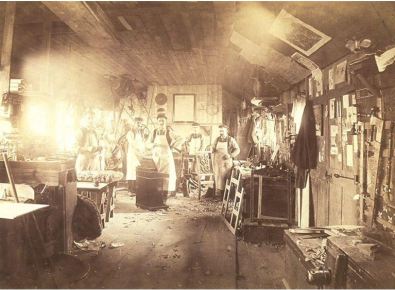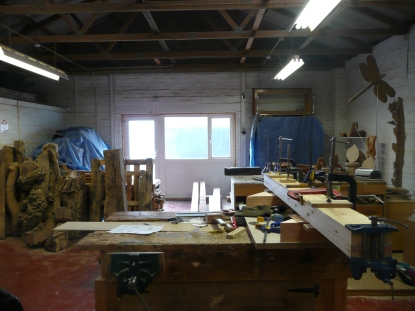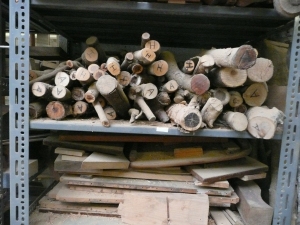Neil is a specialist joiner in Selkirk who works with native Scottish timber to produce hand carvings, bespoke furniture and architectural joinery. He is a University of Edinburgh graduate and has worked in workshops in Banffshire and Aberdeenshire and is now based in Selkirk.
[On woodworking in Scotland]..Well, I think the Victorian stuff is very interesting. The metal they used for their chisels and that kind of thing is a much better quality than we get nowadays, the blades last a lot longer, they have more specific tools for each job rather than, I don’t know, a router or something that can do lots of different jobs. You would have all the moulding planes that would try and get the mouldings manually. Also, my great-grandfather was a joiner, and I’ve got a lot of his moulding planes and tools, some of which I still use. It’s good, seeing that tradition hand down, if you like.
I remember seeing his [great-grandfather’s] workshop. It was a sort of shed at the bottom of the garden… With a diesel engine in it and wide, six, seven inch wide pulleys everywhere, that would have worked the saws and the lathe and everything like that. I remember it …always having a nice smell in the place. And I’ve got his handsaws as well, that’s another thing I have. It’s great, very nice. I’ve also got a box…called a gentleman’s tool box, or tool chest, just a wooden box about eighteen inches by ten…with a full set of tools in miniature, like you might get at Halford’s or B&Q or something now. All these miniature but really good quality tools. And I picked up one or two of them with the box, which I picked up for a tenner, and then I’ve been trawling various jumbles and that kind of thing, and picked up a whole load of tools that, some of them had the same pattern handles as the originals, so it’s the same maker’s stamp on them. So it’s a good collection. And I use them at home, that’s my toolbox.
[On the Tain workshop – see image] … I can see the pulleys on the roof and belts coming down, so they’ve got some kind of mechanism there for maybe a saw or a lathe or something. Good vice there. Relatively good floor for storing things, for getting on with the work. …They’ve all got good aprons… and moustaches, which is a bit more bizarre. ..Good trestles, although I would find them a bit low, they were maybe for putting work on and then working onto it, as opposed to the bench which is a bit higher up, and it should be about waist height anyway, so you can protect your back. Not lots of window light… it’s a small space for so many people…
…a lot of the stuff looks pretty similar, some of the vices and that kind of thing, they’re at the same height as they would be now, they’d be making the same kind of thing, I’ve made chairs using that system of a framework there. I sometimes wear an apron. …But I think it would be quite similar, I’d be able to go in there and work away, I think, quite happily. Some of it might be a bit slower, but I think once you’d got the hang of the pulley thing that would be all right.
Working Environment
[What makes a good workshop] A level floor, good light, security at well…Because everything’s so expensive, all the tools.
[On working with an apprentice] I have had an apprentice before, and he was with me for a couple of years just to finish serving his time, so he’s got his joinery ticket…..A lot of the stuff I do is just me, and the material. You know you’ve got to make it to learn how to do it. So we were doing a lot more normal joinery work, making sash and case windows, repairing them, and that kind of thing, making doors. So a more general joinery. But the fact that there was someone else in the workshop I sometimes found a bit bizarre, ‘cos I always had to make sure that he was learning properly and there was jobs enough for him as well. I’m happy enough having enough work for myself, ‘cos if there wasn’t an actual job then I could always just make something anyway. But the boy had to get work and be paid as well!

Stained glass window by Stephen Adam (1848-1910), showing joiners, in Maryhill Burgh Hall. (c) CSG CIC Glasgow Museums and Libraries Collections
Relating to the Work
[On becoming interesting in woodwork] I’m not sure exactly what it was first – just a sort of satisfaction of producing something at the end of however long it took me to make something, I think. And it progressed to more elaborate things that took months to make, you know, musical instruments and restoration jobs that would have taken a long time, and carving things. It was good fun. And you get paid, at the end of it.
This finial here, although it’s just effectively a cylinder at the moment, and I’ve got a plan for it…I have another ten or twelve of those to make. When I’m working on one of those I’ll have dimensions in my head, and I use a caliper to just double check everything, but after a little while, maybe after the fifth of sixth spindle, I’ve got the dimension between by eye and the bit of wood a bit better, and I can almost time myself how long that little bit will take, and I sort of play a mental game about getting that bit done, or another cove, or another groove, or something in the wood in a certain time, or in a better way… And in the end I can halve the time it’ll take me, by the end of maybe ten I’ll be doing them no problem at all. And if I’ve got lots to do, like spindles, I see them in my sleep as well!
…in the last five or six years a lot of the things I’ve made, in the joinery sense, have been re-creating Victorian things. So if they’re next to the original ones in a building, I get a lot of satisfaction from seeing the lack of difference, if you like. How close they were to the originals. And I know that just a bit of sunlight will darken the colour of the wood down and it should blend in, so it’ll be harder to tell that which is the new bit of furniture, like a staircase, or something like that. I like that. And smaller things, sometimes I might get a bit of a surprise because I’d maybe forgotten that I made it, or I might see something, I’d have done a bit differently another time. But usually I get a nice feeling seeing my older work. It’s good.




